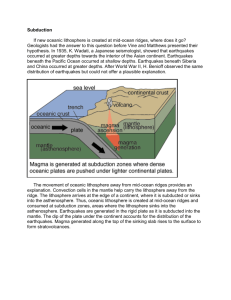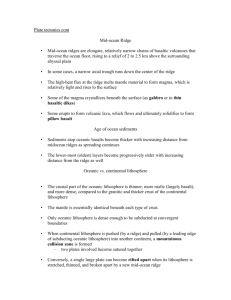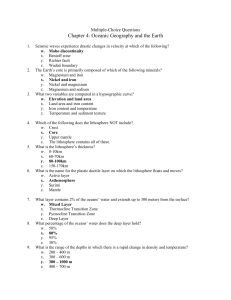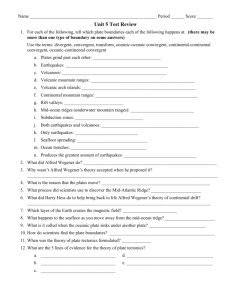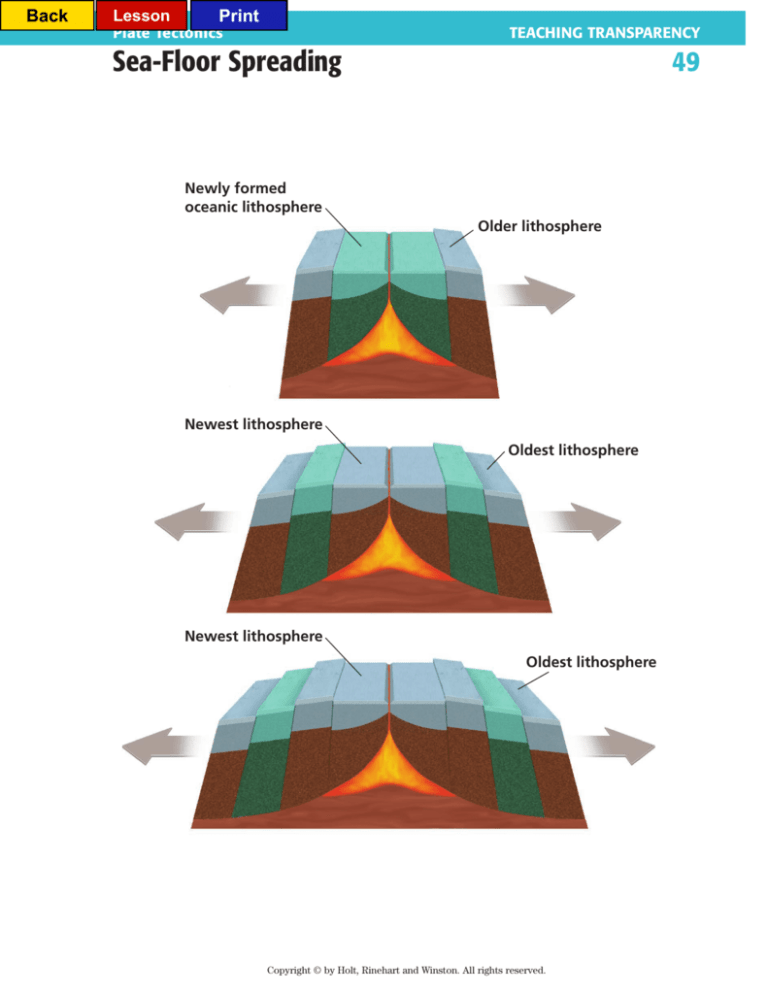
Back
Lesson
Print
Plate Tectonics
TEACHING TRANSPARENCY
Sea-Floor Spreading
49
Newly formed
oceanic lithosphere
Older lithosphere
Newest lithosphere
Oldest lithosphere
Newest lithosphere
Oldest lithosphere
Copyright © by Holt, Rinehart and Winston. All rights reserved.
Back
Lesson
Print
Name
Class
Date
Transparency Worksheet
Sea-Floor Spreading
1. What is new oceanic lithosphere made from?
2. Why does this material rise to the surface at mid-ocean ridges? What are midocean ridges?
3. Where in relation to a mid-ocean ridge would you find the oldest oceanic
lithosphere?
4. Where would you find the oldest oceanic lithosphere in relation to
continents?
5. The concept of sea-floor spreading suggested evidence that the continents,
too, were moving. Why did scientists reach this conclusion?
Copyright © by Holt, Rinehart and Winston. All rights reserved.
Holt Earth Science
Plate Tectonics
Back
Lesson
Print
ANSWER KEY
2.
3.
4.
5.
48 Fossil Evidence for Gondwanaland
are closer to the surface, so studying
the fossils in younger rocks is easier.
488 million years ago
about 63.7 million years
Precambrian time is the longest geologic
time span in Earth’s history. It is poorly
represented because very few fossils
exist from the unit of geologic time.
Forests and swamps that contributed
vegetation to the deposists covered
large areas.
1. South America, Africa, Australia, Asia
(India), and Antarctica
2. Africa, Asia, and Antarctica
3. Mesosaurus
4. South America, Antarctica, Asia
(India), and Australia were likely
touching Africa.
5. Africa, Australia, and Asia, (India),
were likely touching Antarctica
6. Answers may vary. sample answer:
The organisms did not appear in other
parts of the world and were not part of
the Gondwanaland part of Pangaea.
7. Answers amy vary. Students may state
that because the trend has been for
the continents to separate, they would
likely continue to move farther apart.
45 Similar Skeletal Structures of
Mammals
1. that any mammal species has five dig-
its on each limb
2. their different means of locomotion
3. The bat’s “wrist” joint is most
prominent. The cat’s “elbow” joint is
most prominent. You can tell
equivalent joints by the bones that
make up the joint.
4. Limb changes are most extreme in the
dolphin. It is the only mammal shown
that moves exclusively through water.
49 Sea-Floor Spreading
1. from magma deep inside Earth
2. Magma can arise at mid-ocean ridges
because the crust is rifting at these
sites. It is rifting because mid-ocean
ridges are the sites where tectonic
plates are pulling apart.
3. The oldest crust is farthest from the
ridge.
4. The oldest crust would be closest to
continents.
5. because sea-floor spreading is due to
pulling apart, or movement of plates,
at mid-ocean ridges
46 Precambian Time and the
Paleozoic Era
1. water formed
2. Precambrian time
3. Pennsylvanian Period of the
Carboniferous Period
4. because of its rich fossil record
5. tribolites
6. The first land plants appeared and the
50 Tectonic Plate Boundaries
first arthropods appeared on land.
7. the Devonian Period
1. 15
2. both continental crust and oceanic
crust
47 The Mesozoic and Cenozoic Eras
3. the region where the Nazca plate and
1.
2.
3.
4.
about 70 million years
the breakup of Pangaea
the Tertiary Period
It drifted to the South Pole during this
epoch; therefore, it most likely was
warmer than it is today.
5. Modern humans first appeared in the
Holocene Epoch and have been on
Earth less than 115,000 years.
6. The Mesozoic Era was longer by 120
million years. The Mesozoic Era lasted
185.5 million years (251 Ma – 65.5 Ma
= 185.5 Ma); the Cenozoic Era lasted
65.5 million years (65.5 Ma – 0 Ma =
65.5 Ma; 185.5 Ma – 65.5 Ma = 120 Ma).
the Pacific plate meet in the southern
Pacific
4. Students should indicate the path of
the mid-ocean ridges that follow the
lines delineating the tectonic plates
around the globe. They should
recognize that the metaphor is a good
one to describe the way the mid-ocean
mountain chains ring the planet.
5. the North American plate and the
Pacific plate
51 Types of Plate Boundaries
1. divergent plate boundary
Copyright © by Holt, Rinehart and Winston. All rights reserved.
Holt Earth Science
13
Answer Key


